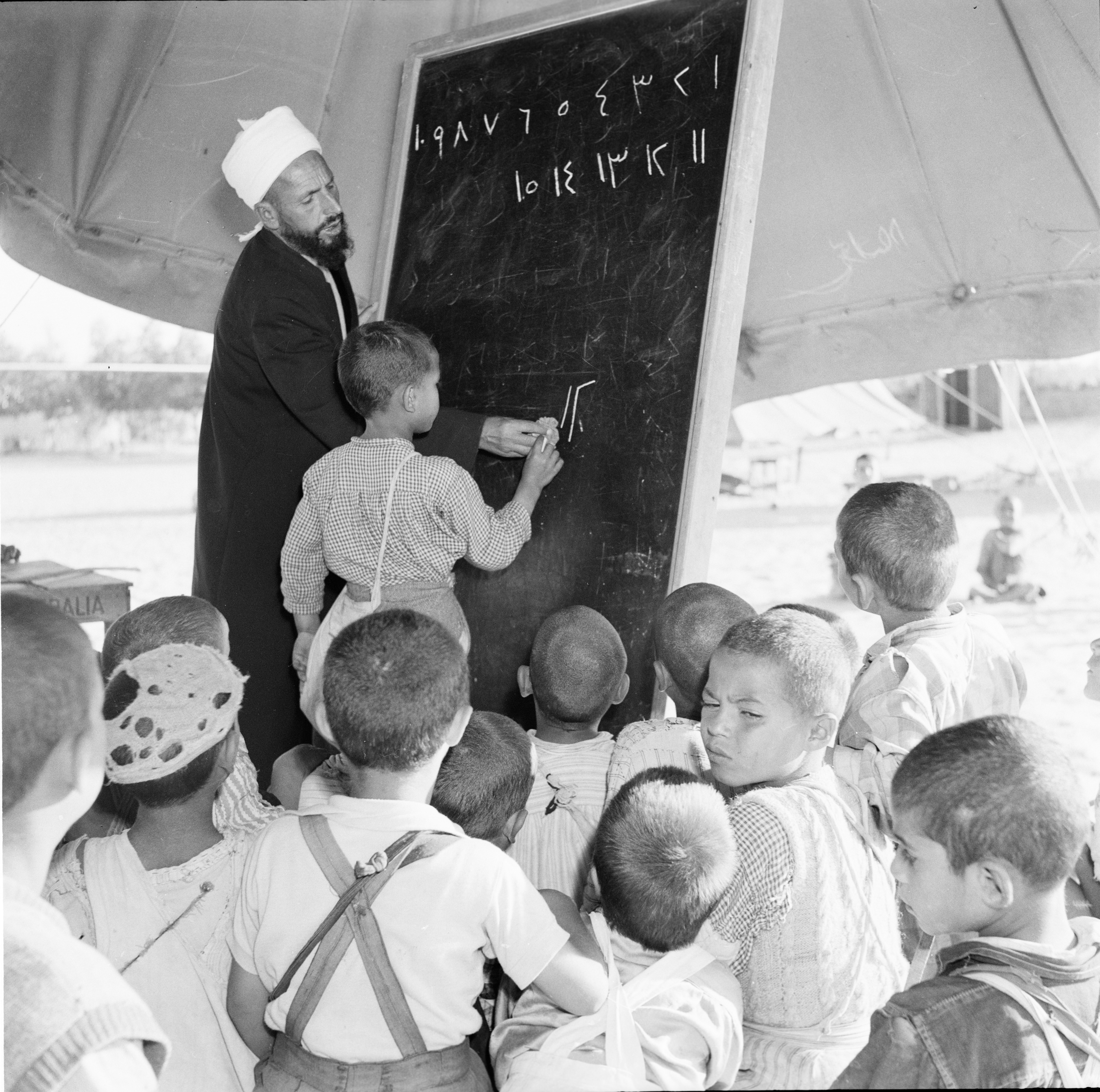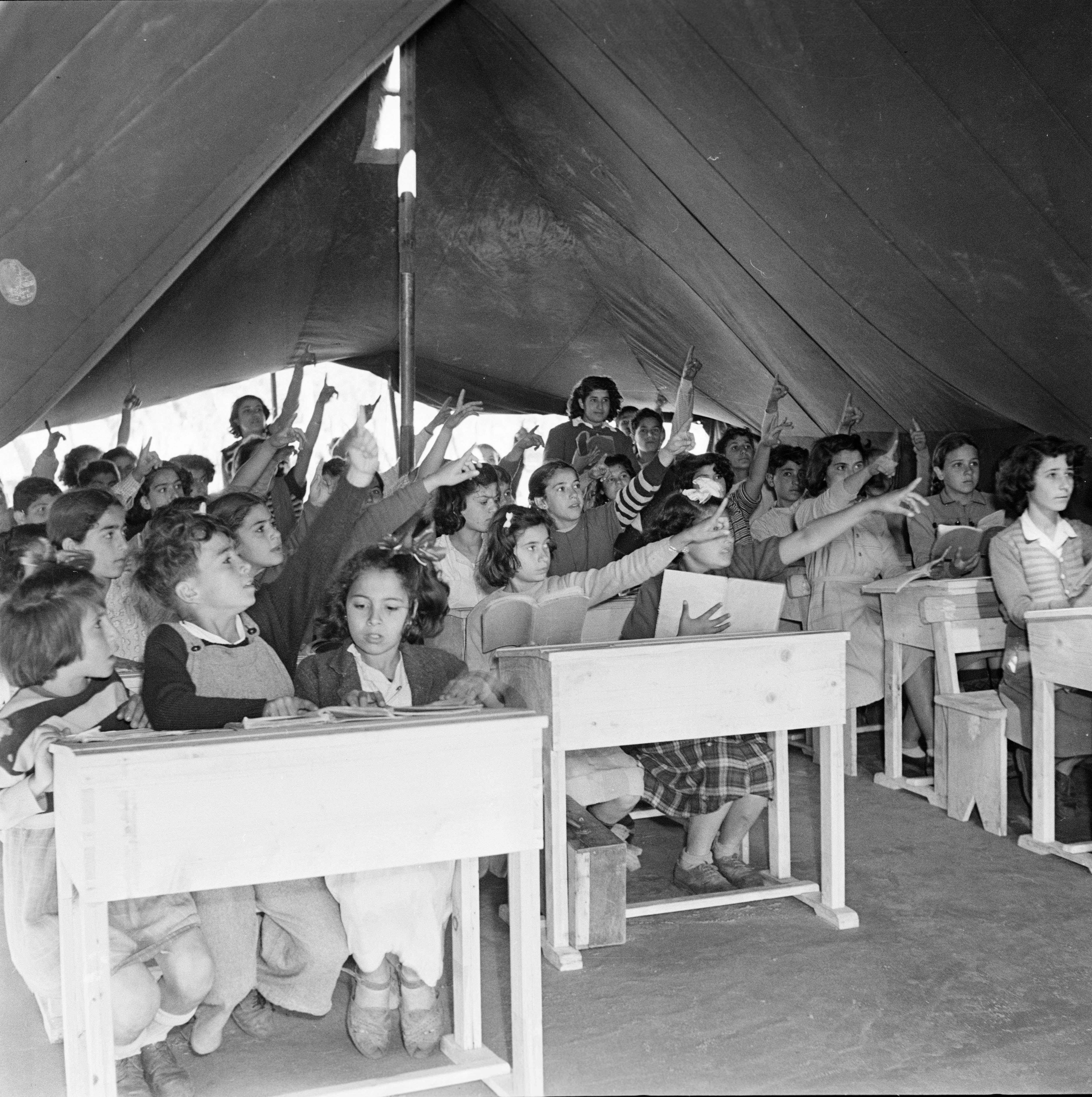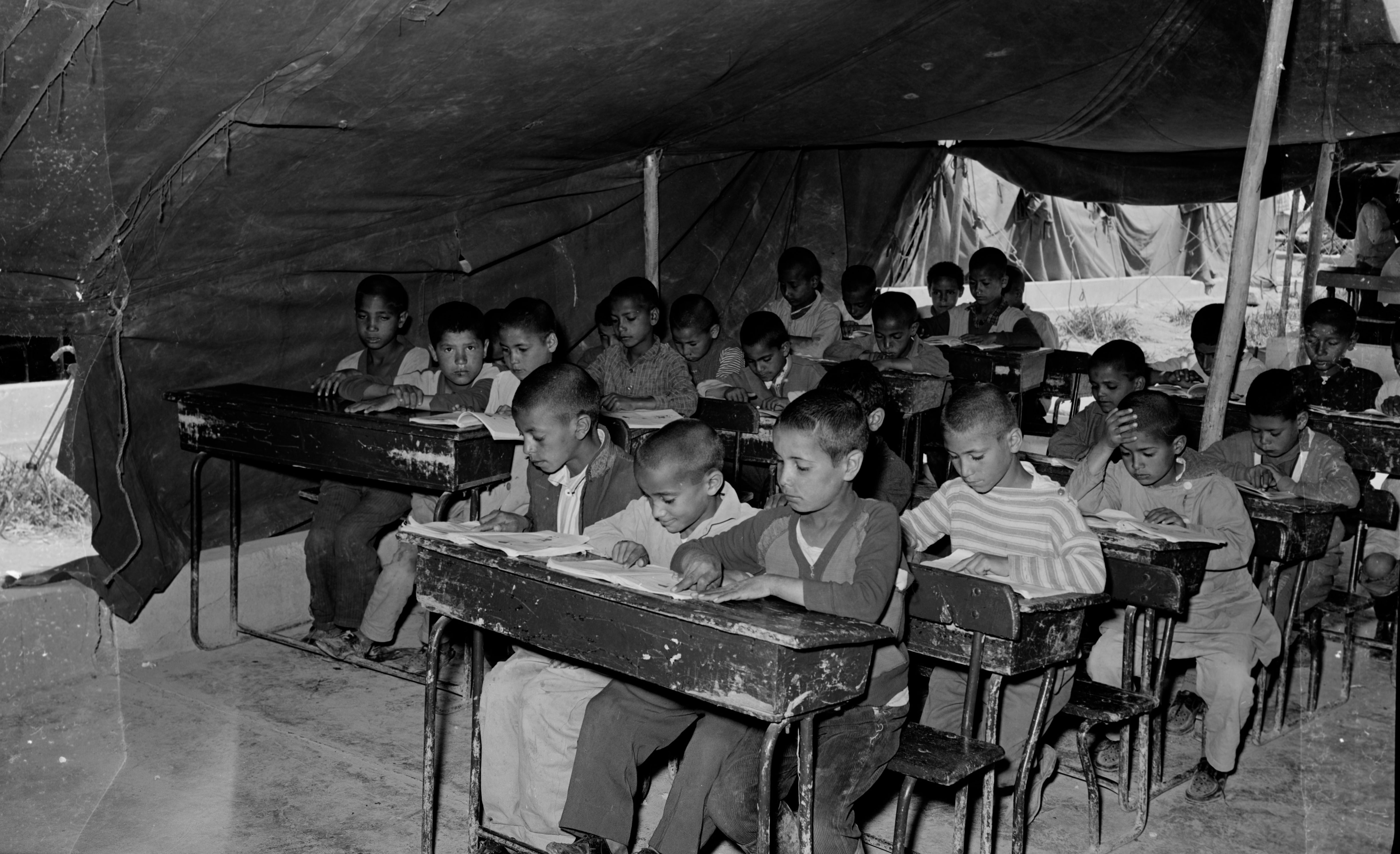al-Jalazone Camp
In its first year, UNRWA opens 93 schools across the region with some 35,000 students. Some, as in this picture from a boys' school in Jalazone refugee camp in the West Bank, were mere tents set up on sand. West Bank. By 1960s, education had become the largest of its programs.
Education has been a crucial element of Palestinian refugees’ lived experiences since the
For Palestinian refugees in camps across the

The Origins of Palestinian Refugee Schools
Despite UNRWA’s close entanglement with education today, the agency was originally created with a very different focus in mind. In fact, the first schools for Palestinian refugees were established not by the
Since the late 1940s, Palestinians worked to set up basic classes and even makeshift schools in the camps. Refugees who had been teachers in Palestine resumed their lessons in exile, finding ways to teach without books, pens, or furniture. They organized classes in tents, vacant shelters, or outside in the open air; some Palestinians in Gaza’s

From Employment and Resettlement to Education
When the UN General Assembly set up UNRWA at the end of 1949, it was designed as a vehicle for refugee jobs schemes in the Arab host states—hence the agency name, which included “works” alongside “relief.” This objective aligned with the concerns of UNRWA’s primary donors and diplomatic backers, the United States and United Kingdom . Although both governments ostensibly supported the Palestinians’ right of return as stated in UN Resolution 194 , they privately favored the alternative “solution” of permanently resettling the refugees in the Arab host states (a plan euphemistically referred to as “reintegration”). Finding stable jobs for the refugees was an obvious first step toward this goal. Moreover, in the political context of the post–World War II period, the Western powers wanted the refugees to find gainful employment, lest they prove susceptible to communist recruitment. Accordingly, UNRWA’s early management sought to create jobs programs in line with the suggestions of the UN Economic Survey Mission , whose 1949 report formed the basis of its work.
This is not to say that education was absent from UNRWA’s early work. In addition to running the jobs programs and providing emergency relief, rations, and healthcare, the agency also took charge of the schools and classes that had been set up in the camps from 1948 to 1950. It significantly upscaled the provision by setting up new schools and introducing free education for all registered Palestinian refugee children across the four fields. Yet in the early 1950s, UNRWA’s focus was definitively on finding employment for Palestinian refugees rather than educating them.
Unfortunately for UNRWA’s senior management, this set of priorities put it at odds with the vast majority of Palestinian refugees, whose cooperation it needed in order to function effectively. Suspecting–not without cause–that the jobs programs were designed at least in part to aid their permanent resettlement outside Palestine, the refugees largely rejected them. Of the 878,000 refugees registered with UNRWA in the early 1950s, the largest number ever employed under its works program was 12,000. They demanded instead that UNRWA invest more resources in education. In fact, even before UNRWA began work in May 1950, Palestinians in the camps had been agitating for more schooling for their children. Such demands continued into the early 1950s and were a prominent theme in the refugees’ formal and informal communications with agency management, appearing in written appeals and petitions as well as in UNRWA staff’s meeting notes.
The refugees would ultimately achieve a victory on this front, although it would be decades before agency management acknowledged it. With the jobs programs proving costly and inefficient as well as unpopular, UNRWA began to shift its focus to education as an alternative approach. By the end of the 1950s it had quietly dispensed with the jobs schemes (although it retain the word “Works” in its title). Schooling became the new priority, with the number of UNRWA schools increasing from 61 in 1950 to 386 in 1958. In 1960, education became UNRWA’s single largest program in terms of investment, funding, and personnel, and the last tent school was replaced by a permanent structure. Thereafter the education program continued to expand, with its portion of the agency’s regular expenditure increasing from one-third in the mid-1960s to more than half by the mid-1980s. In 1987, UNRWA Commissioner-General Giorgio Giacomelli acknowledged in an interview that the refugees’ advocacy had been a major factor in the agency’s decision to drop resettlement as an early goal.
The success of the UNRWA education program had significant knock-on effects. At its zenith, UNRWA schooling was considered so outstanding that even Palestinians who were not registered refugees, and other nationalities, allegedly sought (unsuccessfully) to enroll their children. The program’s high quality enabled some graduates to secure scholarships for higher education and then compete successfully on the Arab job market. In the second half of the twentieth century, many Palestinians moved to
Curriculum Clashes
As UNRWA’s flagship program, education in the Palestinian refugee camps has faced continual criticisms over the years. Perhaps most notoriously, anti-Palestinian critics of the agency have often zeroed in on the content taught in its schools, alleging that it promotes anti-Israeli bias and even terrorism. Such contentions were first raised by the Israeli authorities after 1967, when schools in the West Bank and Gaza Strip were placed under the spotlight soon after the occupation began. Thereafter, the occupying Israeli authorities regularly inspected UNRWA schools and checked and censored textbooks. The scrutiny was so intensive that UNRWA teachers, overwhelmingly Palestine refugees themselves, complained in the 1970s that they were unable to do their jobs because they lacked the necessary resources, with textbooks being held back until the Israeli inspectors were satisfied.
While the Israeli authorities have often denounced the agency’s curriculum and textbooks, it is in fact erroneous to speak of either an “UNRWA curriculum” or “UNRWA textbooks.” From the beginning, UNRWA schools have followed the host state curricula, using the relevant governmental textbooks accordingly. Prior to Oslo Agreement
and the establishment of the
The content taught in UNRWA schools has also received criticism from Palestinians. Historically, the use of host state curricula and textbooks meant that Palestinian refugee children received no education in their own national history and geography. Instead, Palestinian history was largely subsumed under broader themes such as the role of the Arab states in 1948; in Lebanon, Palestine hardly appeared in the public education system at all. From the beginning, Palestinian teachers had sought to educate their pupils as far as possible in national history and geography, often doing so informally as they lacked the relevant materials in exile. In 1949, a group of Palestinian educators had even appealed unsuccessfully to UNESCO to develop a national Palestinian education system.
As the camp education system became increasingly formalized under UNRWA’s management, the absence of Palestinian-specific content came to the fore as a primary grievance for many refugees.
The schools that UNRWA sponsored were designed–unwittingly or not–to raise Palestinian children on, and educate them in, accepting their plight of life as a preordained thing…. No attempt was made to explain the situation and the forces behind it that ruled their lives, or how they were to respond to them… No courses were offered to show where they came from, the history of Palestine.
In response to the situation, Palestinian teachers increasingly organized and agitated for the inclusion of national history and geography in UNRWA schools. This demand frequently featured in industrial action by UNRWA teachers from the 1950s onwards; at times, students also demonstrated against the curriculum in UNRWA schools.
For a long time UNRWA resisted pressures to introduce a specifically Palestinian curriculum. Management argued that it was necessary to use the host state systems so that refugee children could later participate in higher education in the countries where they lived and compete on the job markets there. But once again, the refugees had something of a victory on this front. In the late 1960s, UNRWA management appointed educational consultants in Lebanon to look at enhancing the existing curricula with more Palestinian-specific teaching. In correspondence with the UNESCO director-general, UNRWA leadership cited pressure from Palestinian teachers as a key factor behind the decision. The consultants went on to develop a Palestinian history syllabus for the elementary and preparatory levels, along with several new textbooks and a teachers’ guide. These additional elements were introduced into UNRWA schools in Lebanon in the early 1970s, with the intention that they would eventually be rolled out across all fields.
Unfortunately for the Palestinians, this never happened. After the
Nevertheless, Palestinian refugees’ dedication to education has continued across time as well as space. It remains constant in the third decade of the twenty-first century, most recently manifested in the refugees’ organized protests against cuts in the agency’s schooling provision. As education remains UNRWA’s single biggest program, it is worth remembering that it came about in the first place due to activism and pressure from the refugees themselves.

Abu Lughod, Ibrahim. “Educating a Community in Exile: The Palestinian Experience.” Journal of Palestine Studies 2, no. 3 (1973): 94–111.
Bocco, Riccardo. “UNRWA and the Palestinian Refugees: A History within History.” Refugee Survey Quarterly 28, no. 2-3 (2009): 229–52.
Irfan, Anne. “Educating Palestinian Refugees: The Origins of UNRWA’s Unique Schooling System.” Journal of Refugee Studies 34, no. 1 (2021): 1037–59.
Irfan, Anne. Refuge and Resistance: Palestinians and the International Refugee System. New York: Columbia University Press, 2023.
Kelcey, Jo. “Curriculum Choices for Refugees: What UNRWA’s History Can Tell Us about the Potential of UN Education Programs to Address Refugees’ ‘Unknowable Futures’.” Journal of Refugee Studies (2023): https://doi.org/10.1093/jrs/fead034
Sayigh, Rosemary. “Where Are the History Books for Palestinian Children?” Journal of Holy Land and Palestine Studies 16, no. 2 (2017): 145–75.
Shabaneh, Ghassan. “Education and Identity: The Role of UNRWA’s Education Programmes in the Reconstruction of Palestinian Nationalism.” Journal of Refugee Studies 25, no. 4 (2012): 491–513.
Fawaz Turki, The Disinherited: Journal of a Palestinian Exile (New York: Monthly Review Press, 1972),
Related Content
Diplomatic Institutional
UNGA 194 (III): Establishment of a Conciliation Commission for Palestine (UNCCP)
1948
11 December 1948
Diplomatic Institutional
UNGA 302 (IV): Establishment of Agency for Palestine Refugees (UNRWA)
1949
8 December 1949
Social-Economic Policy-Program
The Education of Palestinians in Israel
Struggling to Break Free from a System of Marginalization